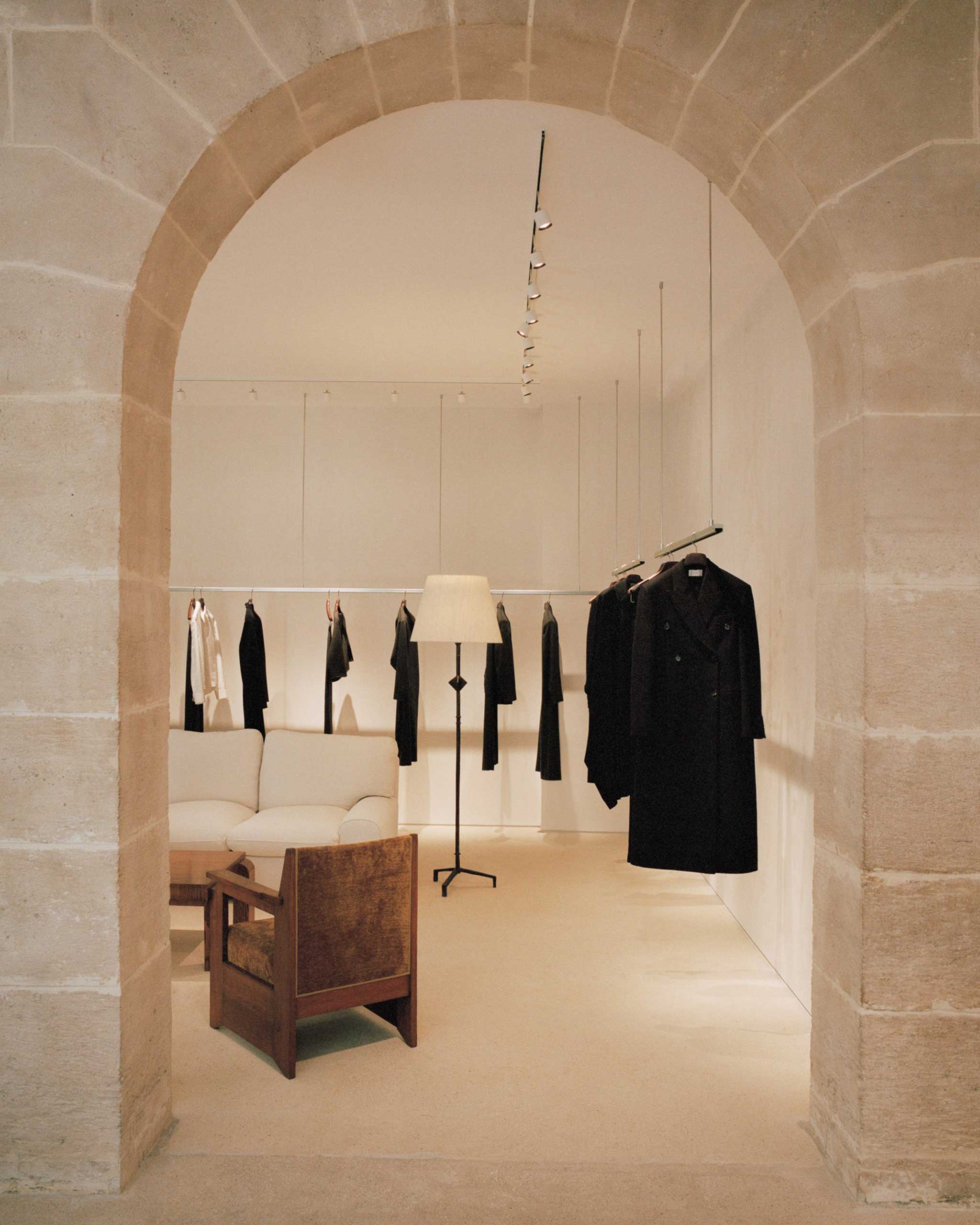Photo: Courtesy of The Row
It is a gloriously sunny September morning in Paris, and something about rue du Mont Thabor—an anonymous street sandwiched between rue de Rivoli, in the shadow of the Louvre, and rue Saint-Honoré, lined with boutiques from Balenciaga, Armani, Moynat, and Burberry, et al—is looking particularly kissed by the light.
At 1 rue du Mont Thabor, at the corner of rue d’Alger, that’s especially true. Mary-Kate and Ashley Olsen are at the doorway to welcome me, both dressed in long layers of black of their own design dotted with gleaming yet discreet antique jewelry, their faces wreathed in smiles. They are, after all, on the threshold of making a long-held dream of theirs—opening a store for their label, The Row, in Paris—come true. It’s been a long time in the making—quite literally.
“We’ve been looking for years, but then we look everywhere all the time,” said Ashley, ushering me in. “We wanted to be in Paris before we opened in London, but we didn’t find anything here first. Then, 18 months ago, a friend told us about this place.”
They liked that it wasn’t a cookie-cutter boutique space—it had been a restaurant, and the twins would surreptitiously drop by to check it out as they decided on whether to take it or not—and that it was located on a corner and lined with lots of generously sized windows. “Having so many windows is amazing, but also a challenge,” said Mary-Kate, laughing, “because Ashley and I don’t like putting anything in our windows.” Instead, they have some blinds, which are edged with ribbons, designed by Lilou Marquand, whose work they are crazy about, and who has quite the pedigree—she once assisted Coco Chanel. Yet the Olsens are also cognizant that their Paris store is part of a living, breathing neighborhood—and the windows, when the blinds are open, will allow passers-by to glance in and see what’s inside during the day, while the space will be lit to feel homey at night.
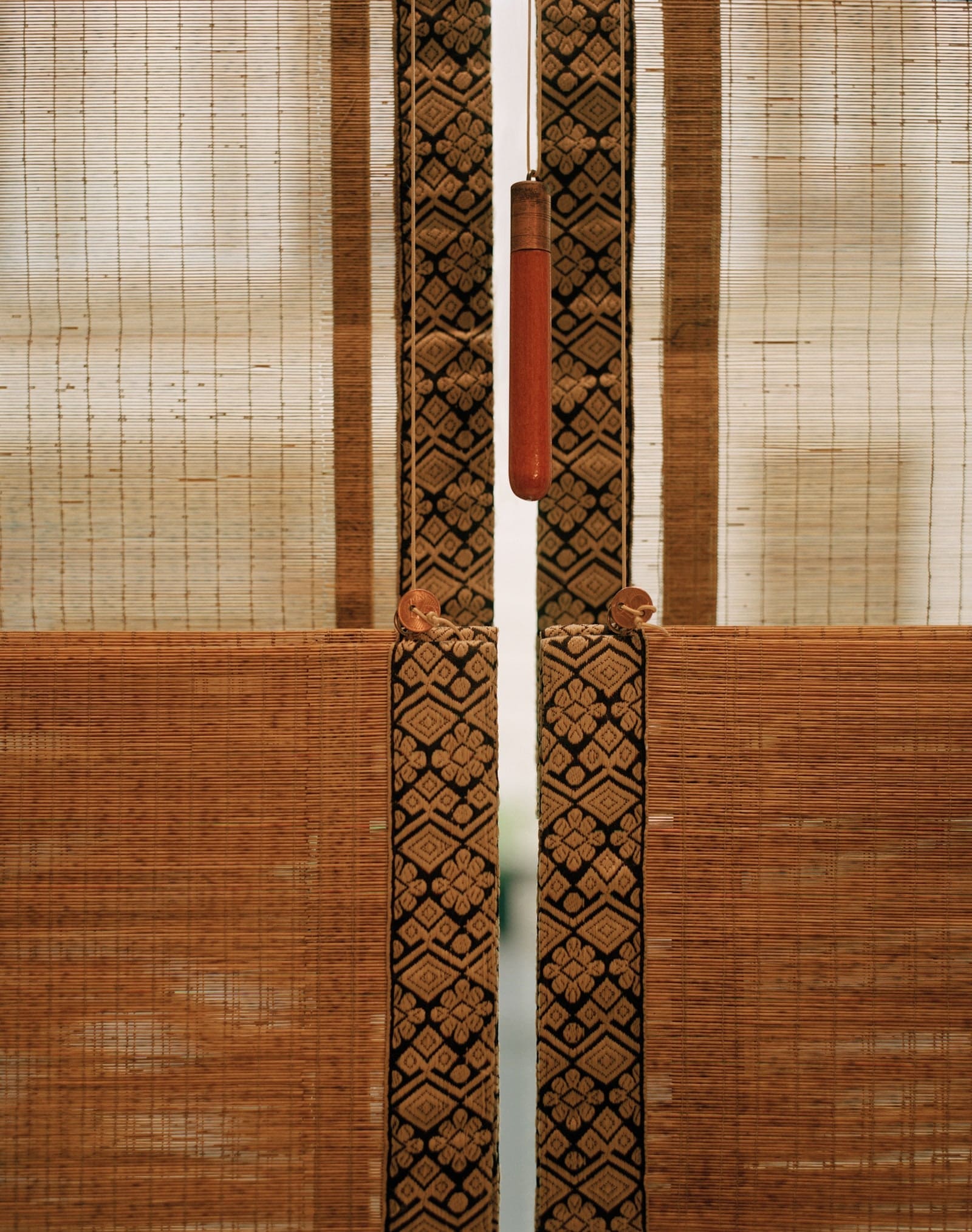
“It has to be a nice experience for the community—a sense of the store being local,” said Ashley. Equally, they’re focused on making sure that anyone who comes by—whether or not they are among those who love to buy and wear their clothes—feel cared for and looked after. “We want the experience to be unique and special,” she added. “Their experience is as important to us as anything else we do.”
The location is, in its own way, the perfect evocation of how the Olsen sisters have skillfully and mindfully steered The Row to where it is now. It also helps explain how the label attracted a recent and much-discussed round of financing reputed to be around a billion dollars, underscoring the phenomenal power and influence of their label and how very seriously it is being taken as a business: Mary-Kate and Ashley manage to be simultaneously at the very heart of things—be it in Paris or in the larger fashion world—while also having quietly and singularly found their home within it on their own terms.
What was immediately striking as we started a tour was that the place felt comfortable and almost casual—well, as casual as any place adorned with exquisite, museum-quality early- to mid-20th century furniture, rugs, and objets —more of which shortly—can be. There’s an intimate and deeply personal vibe at work here that’s about looking refined without ever feeling precious.
I ask them how, as they add another store into the mix (they’re now in Los Angeles, the Hamptons, New York, and London) if it’s important to make their newest outpost—it opens September 24th—clearly connect with the rest. “Does it feel like a The Row store to you?” asked Mary-Kate, laughing. “Because we just moved in.” And yes, aesthetically and vibe-wise, it does. The last time I wrote about a new store of The Row’s (in New York, which opened some nine years ago), I mentioned that I wanted to burn everything I owned and move in. The feeling now is the same—except, along with the arson, I’d also be faced with having to take a crash course in learning French. (A petit price to pay, let’s be honest.)
To get to where their Paris store is now took many months of diligent work—a painstaking process of peeling back and stripping away and tearing down, with the sisters dropping by every three weeks or so to check on how things were going, with a few surprises along the way for both them and their in-house design team of advisers. This is the first store designed this way, with the Olsens having previously turned to the likes of legendary interior decorator Jacques Grange to help realize their vision. “The best way to describe the whole process,” said Ashley, “was a series of baby steps, which we did with a bunch of people who were happy to try with us.”
In its former life as a restaurant, the space had been a configuration of small, interlocking dining rooms with a walled-off kitchen slap bang at the center. What was slowly revealed through the renovation, though, was the true extent of the building’s footprint. “We couldn’t at first tell that it could be such an open space,” says Ashley. “It was all so closed off, but we started to see an opportunity for more flow.” What also emerged were some wonderful original features, which didn’t at first glance feel like they quite belonged together but somehow, now, magically do. “We wanted to keep the integrity of the floors, the columns, the walls,” she continued, “to keep all the elements and make it coherent.”
That’s evident from the way the disparate has been synthesized into the harmonious—by the exposed industrial piping, which is echoed by the tubular racks bearing their clothes; by the monumental yet quite rustic stonework arch, which leads further into the back of the store; by a back wall of stained glasses which had been, before the renovation, shamefully neglected by being covered up; and by the absolutely fantastic aged and weathered wooden pillar which rises from the floor to the ceiling and looks for all the world like it could have come from a Victorian schooner. (In one corner, mirroring it, is a somewhat newer addition: a columnar wooden plinth by furniture designer Marcel Coard.)
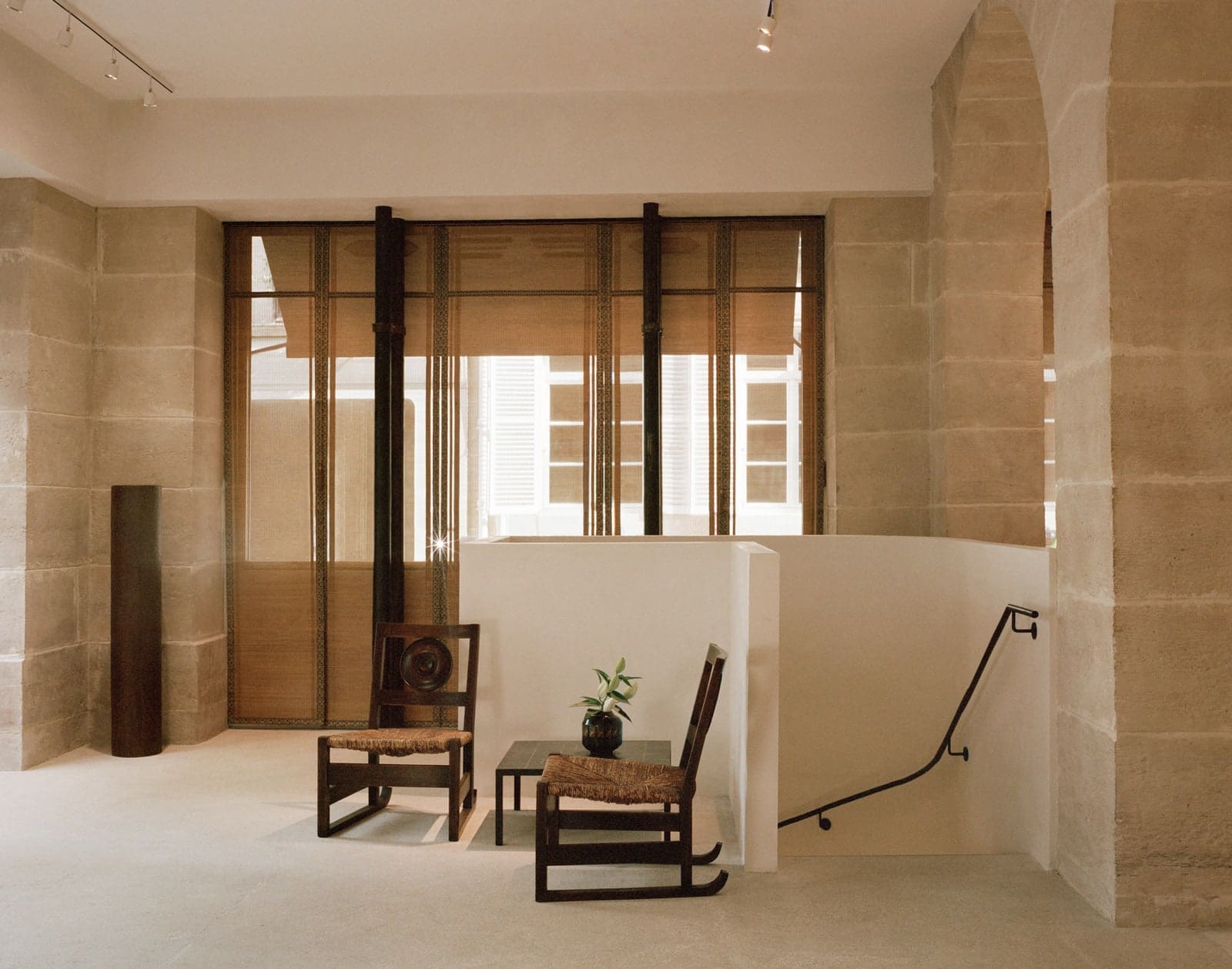
Unlike so many boutiques which want to shock and awe by exalting luxury and status before greeting you (rather incongruously) with a barrage of product which rather defeats that whole intention, no such ploys are in play here: The store opens straight into a welcoming, almost domesticated seated area, with two wooden Traineau chairs by Victor Courtray which date from 1940, a mix of homespun rush seating and a back of geometric lines, which flank a black 1955 Georges Jouve coffee table.
As you pass through that high stone arch just behind them, you’re greeted by some cozy custom-built seating that’s more Californian in spirit, along with a modernist 1930s coffee table by Michel Dufet.
The tour then continues through an arched opening into the adjacent room, past the two Henrik Wouda armchairs upholstered in a chenille-y golden velvet, the vintage notions counter which now holds their luscious leather purses, and—my eyes were bugging out with desire, I cannot lie—a magnificent rust and beige Ivan da Silva Bruhns rug from 1934. (Other carpets are the work of Eileen Grey and Jean Lurcat.)
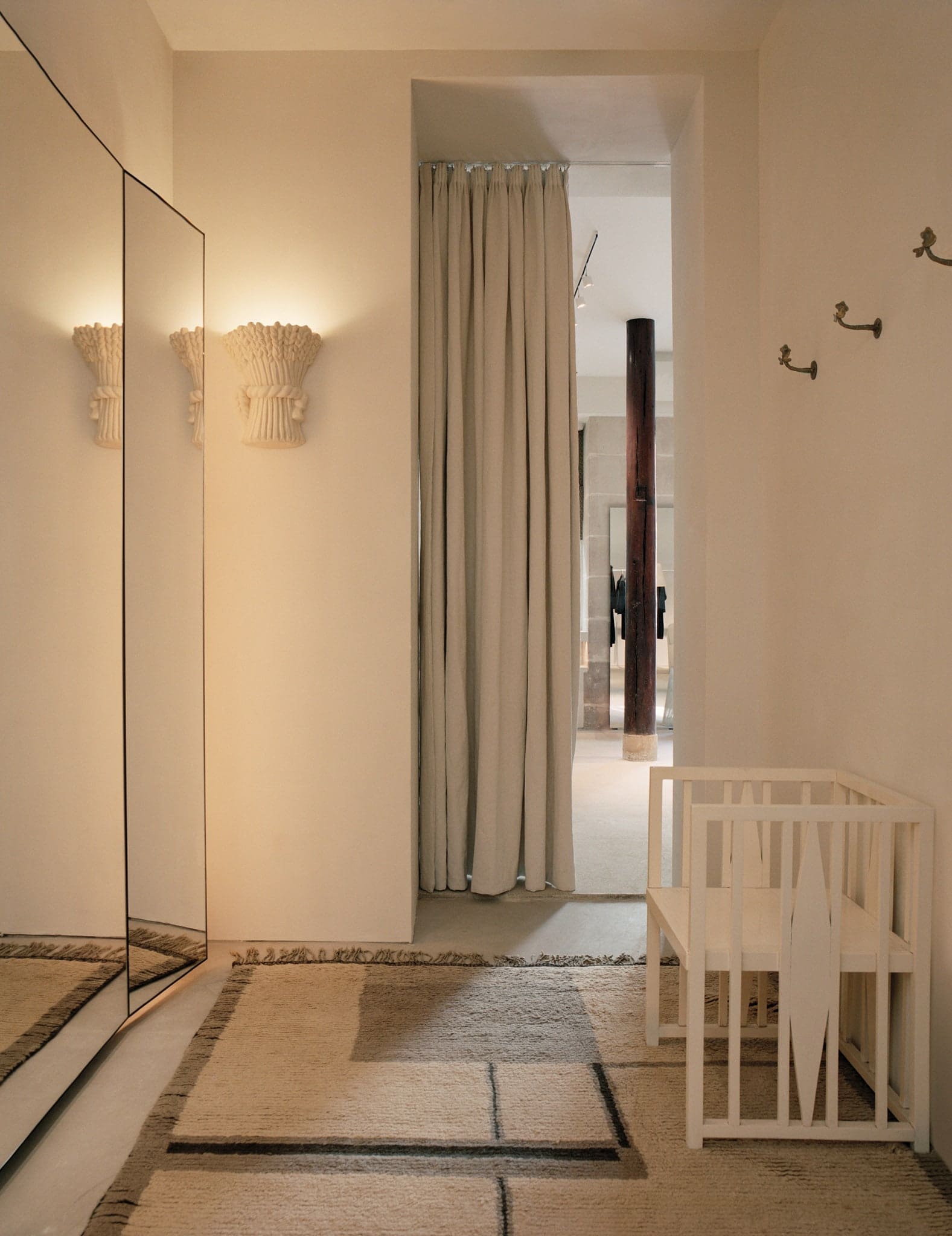
Mary-Kate opens a door of one of the changing rooms, and the three of us peek inside. It features an ivory lacquered cuboid chair by Koloman Moser and Wiener Werkstatte dating back to 1900 and a pair of 1940s white wheatsheaf sconces by Vadim Androusov. By the espresso bar—its handsome 1950s-style coffee machine crowned with small ceramic tumblers the sisters sourced from Commune in Los Angeles—is another changing room.
To enter that, you slide a handsome steel door with six small portholes, the other side of it backed with beautifully aged wood. It reminds me of the decor of the swanky and delicious Left Bank fish restaurant Le Duc, the design of which evokes a particularly chic ’70s yacht. “Was it once part of a kitchen?” I asked the Olsens of the door. Barely missing a beat, Mary-Kate replied, “It’s Jean Prouvé.”
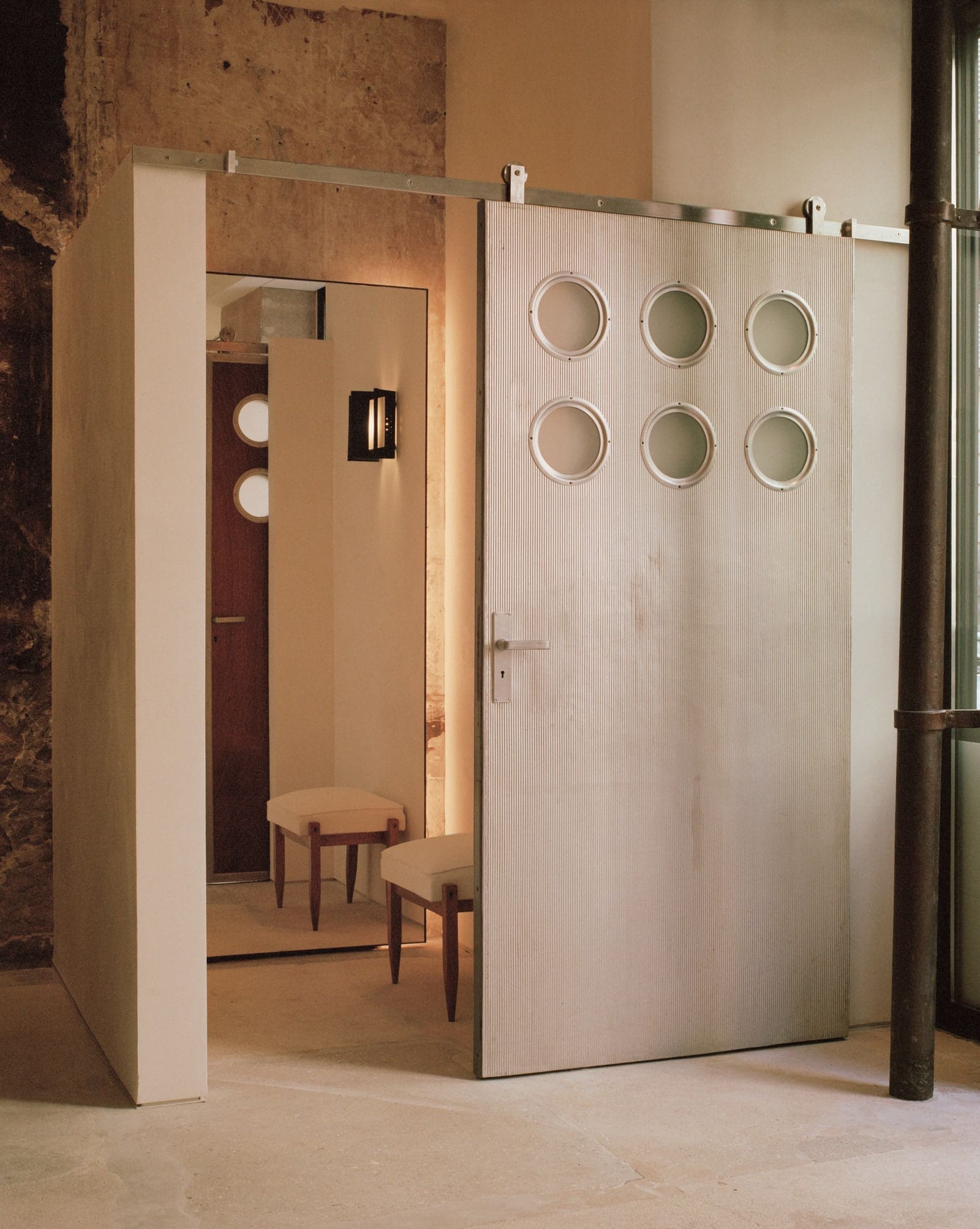
Uh-oh. This reminds me of the time many years ago when I went to interview Ann Demeulemeester at her Le Corbusier-designed home in Antwerp just before the holidays. She and I wandered into her atelier, where over one of the cutting tables hung a series of suspended wire coat hangers—similar to the type you’d get from the dry cleaners—in a very Yule tree-like configuration. “What a great holiday decoration,” I said to Ann. “It’s by Man Ray,” deadpanned Demeulemeester. Again, uh-oh. The sisters laughed as I recounted my other moment of aesthetic ignorance. “But it would have made a great holiday decoration,” said Mary Kate.
By now we are back sitting on the custom couch, and we fall more generally into what it means to be opening in Paris. They have leaned into their infallible instincts—they’re too modest to say that they possess them, but they do: “We don’t really try to get it right,” said Mary-Kate. “We just try to learn”—about what Parisians might want to buy from them, about what is going to fly. “We will have special pieces in the mix,” she said, “but we think it will lean more towards the casual.”
“We just want to open, because there are so many learnings when you do,” said Ashley as we wrap things up. “You need to be very agile, and to make adjustments, so opening the doors and learning one day at a time… that’s very us. This may not be the most obvious place to be in Paris—we looked at almost every major street in the city—but we’re very happy here.”
This article was originally published on Vogue.com.
